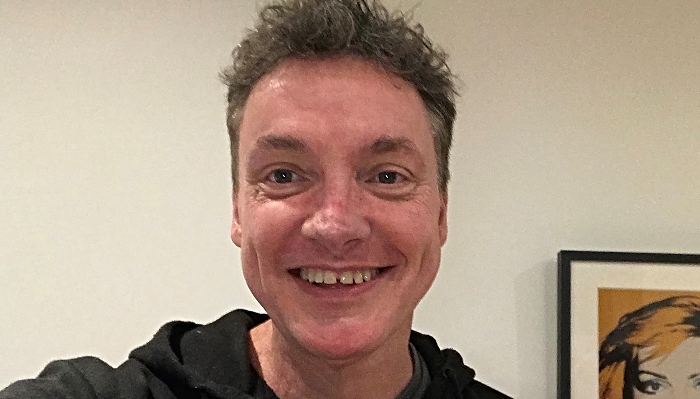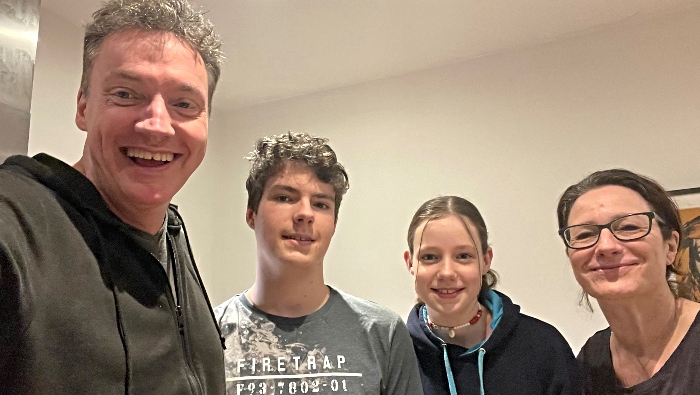
A father-of-two from Nantwich, who was treated with proton beam therapy as part of a clinical trial, will share his experience with other patients at a high-profile conference.
Michael Schillinger, 57, was diagnosed with head and neck cancer in 2020 after finding a lump while shaving.
He was referred to The Christie in September 2020 and became only the ninth adult patient to join the TORPEdO clinical trial.
The trial compares the impact of proton beam therapy with conventional radiotherapy for patients with oropharyngeal cancer.
As a result of his experience, Michael has been invited to speak at a proton consumer day virtual conference on April 28.
Michael, who runs The Chilwell Arts Theatre in Nottingham, found a lump while shaving towards the end of July 2020.
He wasn’t sure if it was just a swollen gland, so he asked his GP who was convinced it was cancer and made an urgent referral for tests, scans and a biopsy.
The cancer diagnosis was confirmed on August 20 by a consultant at Leighton Hospital in Crewe, who believed it to be a stage 4 cancer, the most serious.
Michael, who is dad to Ben, age 16 and Kate, age 12, admits the diagnosis was a frightening and traumatic life-changing event.
He said: “I remember thinking about my children, and it really hit me that they might have to grow up without a dad there to support them into adulthood.
“I wanted to keep things as normal as possible and didn’t want them worrying. My wife Jackie was also extraordinary.
“She took on the entire responsibility for the family during that period.
“I was referred to Dr Price at The Christie in September. Meeting him helped to change my whole outlook on the diagnosis.
“Until then, I had felt out of control, but Dr Price explained everything and what it meant.
“He was the first person to give me hope, particularly when he told me that the cancer had been caused by HPV rather than lifestyle factors and was stage 3 rather than stage 4.
“He told me he was cautiously optimistic about a good outcome and asked if I wanted to join the TORPEdO clinical trial to use proton beam therapy rather than conventional radiotherapy.
“I immediately said yes, as my consultant at Leighton had already recommended that I should.
“Once I was accepted onto the TORPEdO trial my care transferred to Professor Thomson who was also very reassuring and gave me hope.”
Michael had two 18-hour chemotherapy infusions at The Christie and 33 proton beam treatment sessions.
“I can’t imagine having a better experience anyway in the world,” he added.
“The staff were remarkable, very attentive, and every detail had been thought about.
“It really felt like I was important to them. They even had someone I was able to discuss the psychological impact of the diagnosis with, which was very helpful.”
As Michael had head and neck cancer, he needed to wear a mask that fastened his head down to the treatment table, which he found uncomfortable but tolerable.
He also struggled with swallowing because of the treatment.
“The first two weeks after the proton treatment was the worst,” he said.
“I was struggling to swallow, it was even hard to drink water, but I was determined not to have a feeding tube.”
Michael’s uncle was diagnosed with less severe throat cancer five years before Michael but had a completely different experience as proton therapy was not an option then.
“I am convinced that I’ve had a more positive treatment experience than my uncle,” said Michael.
“He had 22 teeth out before they could do the treatment. I only had one out.
“And he had even worse problems swallowing food and drink than me.
“The treatment affected my saliva glands, but I can now eat practically anything.
“I could even start eating curry again a year after my treatment, but he probably never will.”

Michael says he looks forward to participating in the proton consumer day conference.
“I am pleased to have the opportunity to share my experiences with patients, the staff, and others interested in proton beam therapy.
“If a patient is considering joining a clinical trial, there is a big unknown.
“Hearing first-hand from other patients will give newly diagnosed patients the information they need and more options to consider.
“I think it is also valuable for the professionals involved in proton beam therapy to hear from patients, as it can help them improve an already excellent service.”
Following the head and neck cancer treatment, Michael had a further blow when a scan discovered an unrelated tumour on his kidney.
The position of the tumour meant it was relatively straightforward for a surgeon to remove.
Michael, who is an avid swimmer and film buff, has now made a full recovery.
“I’m currently clear of cancer and expect to stay clear,” he said.
“My last check-up was in December 2022. The next one will be in December 2023.
“I will be monitored regularly for the first five years.
“The aftercare has been first-rate, and it is very reassuring to know that The Christie will keep an eye on me for the rest of my life.”
Any patients interested in taking part in clinical trials should discuss the option with their consultant or GP.
Not all patients will fit the criteria for a specific trial.
While clinical trials can be successful for some patients, outcomes can vary from case to case.
The proton consumer day on Friday April 28 has been organised by The Christie with University College London Hospitals, CTRad, NCRI Radiotherapy Research Group and the Science and Technology Facilities Council.
The conference is open to anyone wanting to learn about proton therapy, particularly potential patients.
Topics covered will include explaining how proton beam therapy works and why it benefits certain groups of patients, what it’s like to have proton treatment for children and adults, proton therapy research and clinical trials and a question-and-answer session with a panel of experts.
Anyone interested can register for the conference at www.eventbrite.co.uk/e/proton-beam-therapy-consumer-day-tickets-594514407597


















Recent Comments